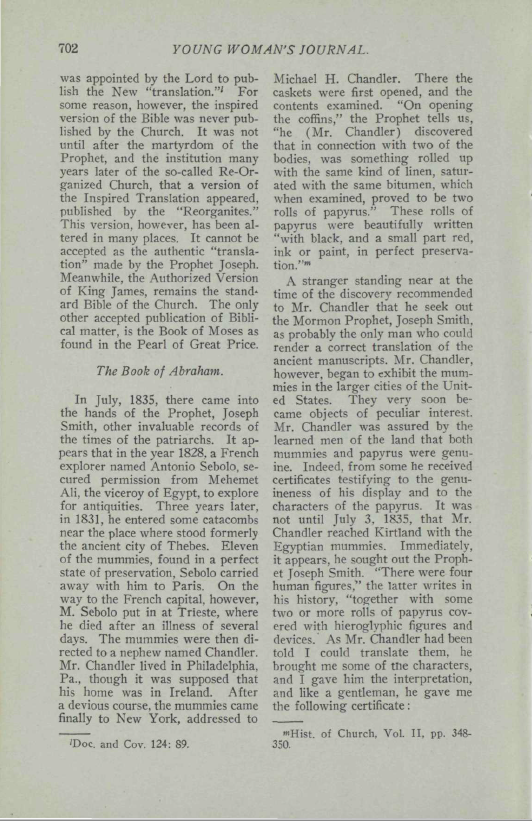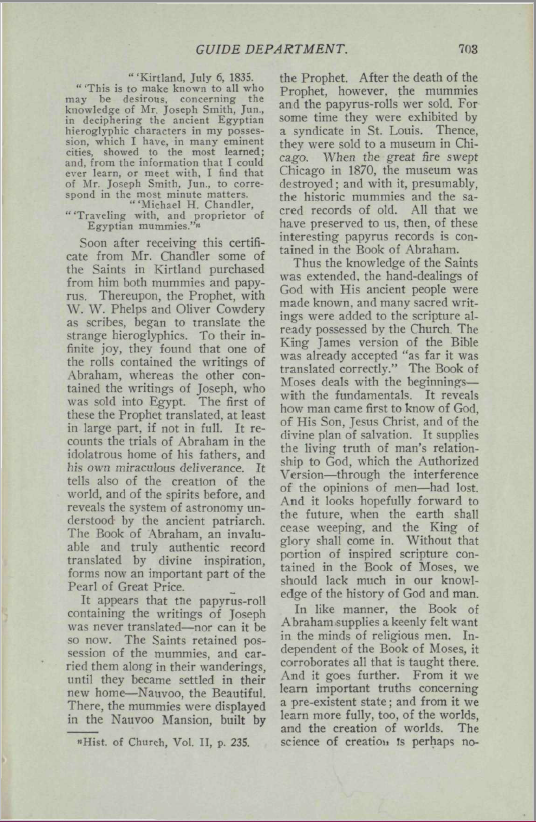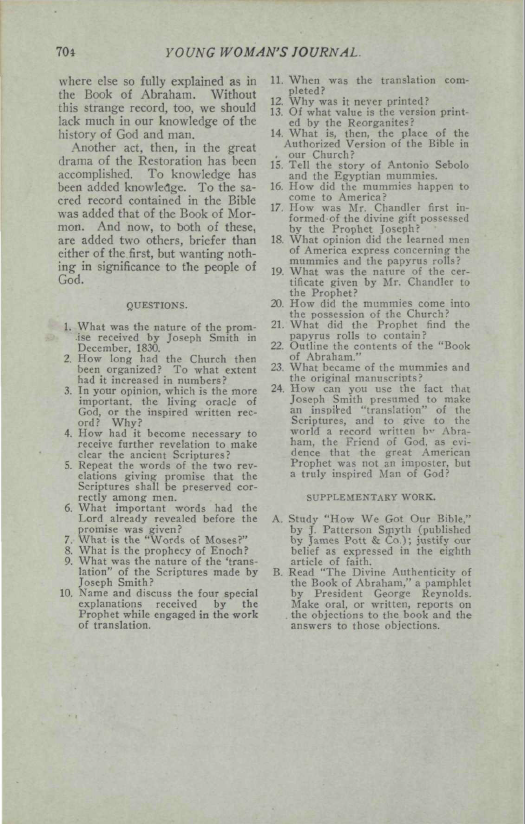Levi Edgar Young recounts history of BOA, says it was translated by inspiration.
- Type
- Periodical
- Hearsay
- DirectLate
- Reference
Levi Edgar Young, "Joseph Smith and Modern Thought," Young Woman's Journal 21, no. 12 (December 1910): 702–704
- Scribe/Publisher
- Young Woman's Journal
- People
- W. W. Phelps, Levi Edgar Young, Antonio Lebolo, Muhammad Ali of Egypt, Michael Chandler, Joseph Smith, Jr., Oliver Cowdery
- Audience
- Latter-day Saints, Reading Public
- Transcription
The Book of Abraham.
In July, 1835, there came into the hands of the Prophet, Joseph Smith, other invaluable records of the times of the patriarchs. It appears that in the year 1828, a French explorer named Antonio Sebolo [Lebolo], secured permission from Mehemet Ali, the viceroy of Egypt, to explore for antiquities. Three years later, in 1831, he entered some catacombs near the place where stood formerly the ancient city of Thebes. Eleven of the mummies, found in a perfect state of preservation, Sebolo carried away with him to Paris. On the way to the French capital, however, M. Sebolo put in at Trieste, where he died after an illness of several days. The mummies were then directed to a nephew named Chandler. Mr. Chandler lived in Philadelphia, Pa., though it was supposed that his home was in Ireland. After a devious course, the mummies came finally to New York, addressed to Michael H. Chandler. There the caskets were first opened, and the contents examined. "On opening the coffins," the Prophet tells us, "he (Mr. Chandler) discovered that in connection with two of the bodies, was something rolled up with the same kind of linen, saturated with the same bitumen, which when examined, proved to be two rolls of papyrus." These rolls of papyrus were beautifully written "with black, and a small part red, ink or paint, in perfect preservation."
A stranger standing near at the time of the discovery recommended to Mr. Chandler that he seek out the Mormon Prophet, Joseph Smith, as probably the only man who could render a correct translation of the ancient manuscripts. Mr. Chandler, however, began to exhibit the mummies in the larger cities of the United States. They very soon became objects of peculiar interest. Mr. Chandler was assured by the learned men of the land that both mummies and papyrus were genuine. Indeed, from some he received certificates testifying to the genuineness of his display and to the characters of the papyrus. It was not until July 3, 1835, that Mr. Chandler reached Kirtland with the Egyptian mummies. Immediately, it appears, he sought out the Prophet Joseph Smith. "There were four human figures," the latter writes in his history, "together with some two or more rolls of papyrus covered with hieroglyphic figures and devices. As Mr. Chandler had been told I could translate them, he brought me some of the characters, and I gave him the interpretation, and like a gentleman, he gave me the following certificate:
"'Kirtland, July 6, 1835.
"'This is to make known to all who may be desirous, concerning the knowledge of Mr. Joseph Smith, Jun., in deciphering the ancient Egyptian hieroglyphic characters in my possession, which I have, in many eminent cities, showed to the most learned; and, from the information that I could ever learn, or meet with, I find that of Mr. Joseph Smith, Jun., to correspond in the most minute matters.
"'Michael H. Chandler,
"'Traveling with, and proprietor of Egyptian mummies.""
Soon after receiving this certificate from Mr. Chandler some of the Saints in Kirtland purchased from him both mummies and papyrus. Thereupon, the Prophet, with W. W. Phelps and Oliver Cowdery as scribes, began to translate the strange hieroglyphics. To their infinite joy, they found that one of the rolls contained the writings of Abraham, whereas the other contained the writings of Joseph, who was sold into Egypt. The first of these the Prophet translated, at least in large part, if not in full. It recounts the trials of Abraham in the idolatrous home of his fathers, and his own miraculous deliverance. It tells also of the creation of the world, and of the spirits before, and reveals the system of astronomy understood by the ancient patriarch. The Book of Abraham, an invaluable and truly authentic record translated by divine inspiration, forms now an important part of the Pearl of Great Price.
It appears that the papyrus—roll containing the writings of Joseph was never translated—nor can it be so now. The Saints retained possession of the mummies, and carried them along in their wanderings, until they became settled in their new home—Nauvoo, the Beautiful. There, the mummies were displayed in the Nauvoo Mansion, built by the Prophet. After the death of the Prophet, however, the mummies and the papyrus-rolls were sold. For some time they were exhibited by a syndicate in St. Louis. Thence, they were sold to a museum in Chicago. When the great fire swept Chicago in 1870, the museum was destroyed; and with it, presumably, the historic mummies and the sacred records of old. All that we have preserved to us, then, of these interesting papyrus records is contained in the Book of Abraham.
Thus the knowledge of the Saints was extended, the hand-dealings of God with His ancient people were made known, and many sacred writings were added to the scripture already possessed by the Church. The King James version of the Bible was already accepted "as far it was translated correctly." The Book of Moses deals with the beginnings—with the fundamentals. It reveals how man came first to know of God, of His Son, Jesus Christ, and of the divine plan of salvation. It supplies the living truth of man's relationship to God, which the Authorized Version—through the interference of the opinions of men—had lost. And it looks hopefully forward to the future, when the earth shall cease weeping, and the King of glory shall come in. Without that portion of inspired scripture contained in the Book of Moses, we should lack much in our knowledge of the history of God and man.
In like manner, the Book of Abraham supplies a keenly felt want in the minds of religious men. Independent of the Book of Moses, it corroborates all that is taught there. And it goes further. From it we learn important truths concerning a pre-existent state; and from it we learn more fully, too, of the worlds, and the creation of worlds. The science of creation is perhaps no where else so fully explained as in the Book of Abraham. Without this strange record, too, we should lack much in our knowledge of the history of God and man.
Another act, then, in the great drama of the Restoration has been accomplished. To knowledge has been added knowledge. To the sacred record contained in the Bible was added that of the Book of Mormon. And now, to both of these, are added two others, briefer than either of the first, but wanting nothing in significance to the people of God.
- Citations in Mormonr Qnas
The B. H. Roberts Foundation is not owned by, operated by, or affiliated with the Church of Jesus Christ of Latter-day Saints.



